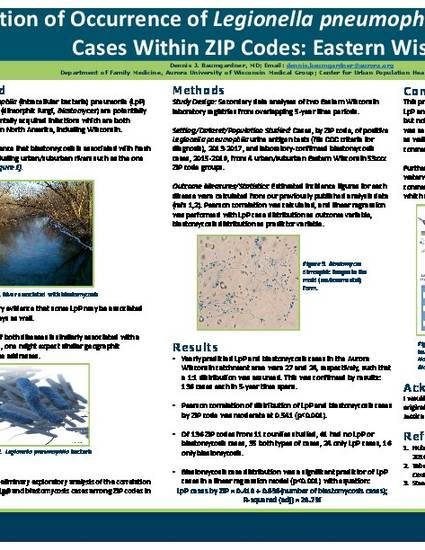
Background: Legionella pneumophila (intracellular bacteria) pneumonia (LpP) and blastomycosis (from the dimorphic fungi Blastomyces) are potentially serious environmentally acquired infections that are both prevalent in Wisconsin. There is good evidence that blastomycosis is associated with waterways and preliminary evidence that some LpP may be as well. If the acquisition of both diseases is similarly associated with a geographic feature, one might expect similar geographic distributions of case addresses.
Purpose: To perform a preliminary exploratory analysis of the correlation of the distribution of LpP and blastomycosis cases among zip codes in eastern Wisconsin.
Methods: We conducted secondary data analyses of 2 ACL Laboratories registries covering eastern Wisconsin from overlapping 5-year time periods: positive L. pneumophila urine antigen tests (LUAT), which fit Centers for Disease Control and Prevention criteria for diagnosis, from 2013 to 2017, and laboratory-confirmed blastomycosis cases from 2015 to 2019. Number of respective cases, by zip code, were compared for zip codes 530xx–532xx and 534xx containing 5 or more LUAT results. One zip code outlier was eliminated. Incidence figures for each disease were calculated from our previously published analysis data. Pearson correlation was calculated, and linear regression was performed with LpP case distribution as outcome variable and blastomycosis distribution as predictor.
Results:Yearly predicted LpP and blastomycosis cases in the eastern Wisconsin catchment area were 27 and 24, respectively, such that an approximately 1:1 distribution was assumed. Pearson correlation of distribution of LpP and blastomycosis cases by zip code was moderate at 0.541 (P
Conclusion: This preliminary, modest correlation of the zip code distribution of L. pneumophila pneumonia and blastomycosis is intriguing given known association of LpP with human-built water sources. It may suggest an undescribed common outdoor environmental source. Further study of LpP and blastomycosis coassociations with waterways, and other potential common sources (or common environmental hosts such as Acanthamoeba in which both can propagate), seems warranted.
Baumgardner DJ. Correlation of occurrence of legionella pneumophila and blastomycosis cases within ZIP codes: Eastern Wisconsin. Poster presented at: Aurora Scientific Day; May 20, 2020; virtual webinar hosted in Milwaukee, WI.

Department of Family Medicine
Aurora University of Wisconsin Medical Group
Center for Urban Population Health